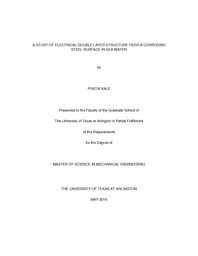
ATTENTION: The works hosted here are being migrated to a new repository that will consolidate resources, improve discoverability, and better show UTA's research impact on the global community. We will update authors as the migration progresses. Please see MavMatrix for more information.
Show simple item record
| dc.contributor.advisor | Yang, Bo | |
| dc.contributor.advisor | Nomura, Seiichi | |
| dc.creator | Kale, Pratik Babanrao | |
| dc.date.accessioned | 2016-09-28T18:08:43Z | |
| dc.date.available | 2016-09-28T18:08:43Z | |
| dc.date.created | 2016-05 | |
| dc.date.issued | 2016-05-10 | |
| dc.date.submitted | May 2016 | |
| dc.identifier.uri | http://hdl.handle.net/10106/25902 | |
| dc.description.abstract | Corrosion is a natural deterioration phenomenon that throws profound adverse effects on the performance of structural steel in marine applications. Seawater consists of various corrosive components such as chlorine ions, sulphate ions and many more. These chemical components are mainly responsible for the corrosion phenomenon. Even though their bulk concentrations are known, their local concentrations and distribution in the vicinity of a steel surface where the corrosion occurs are yet unclear. Without the knowledge, would any approach to deal with the corrosion be empirical, at best. The main objective of the present thesis is to investigate the interfacial structure of an electrical double layer (EDL) and provide mechanistic understanding of the formation of an EDL at a steel surface in seawater environment.
An analytical model is developed on basis of mass transport, electrostatics and fluid mechanics to simulate the specific system at a seawater-steel interface. Parameters such as voltage, corrosion flux and bulk concentrations are varied to examine their effects on the structure of the EDL and hopefully shed light on the mechanism of corrosion at the nanometer scale. The EDL at an anode is considered. The anions, such as SO42-, Cl-, OH-, which would be attracted to the anode, are included in the model. Many cations of corrosion products as well as Na+, SO42-, and other metal ions are also included. It is observed that when voltage increases in the low range from 0 to 0.6 V, the SO42- and Cl- concentrations rise at the metal surface. However, when the voltage is further increased, the SO42- and Cl- concentrations at the metal surface decreases. In contrast, the OH- concentration at voltage range from 0 to 0.6 is low near the metal surface, due to its low concentration in the bulk electrolyte at pH 7. At higher voltage, it however rises while OH- replacing SO42- and Cl- next to the metal surface. Attempt is made to interpret this phenomenon. It may be inferred that SO42- and Cl- should be responsible for corrosion, especially, pitting, in steel, at relatively low voltage. At higher voltages, surface coverage of OH- may retard the corrosion. | |
| dc.format.mimetype | application/pdf | |
| dc.language.iso | en_US | |
| dc.subject | EDL | |
| dc.subject | Corrosion | |
| dc.subject | Seawater | |
| dc.title | A Study of Electrical Double Layer Structure over a Corroding Steel Surface in Sea Water | |
| dc.type | Thesis | |
| dc.degree.department | Mechanical and Aerospace Engineering | |
| dc.degree.name | Master of Engineering in Mechanical Engineering | |
| dc.date.updated | 2016-09-28T18:09:46Z | |
| thesis.degree.department | Mechanical and Aerospace Engineering | |
| thesis.degree.grantor | The University of Texas at Arlington | |
| thesis.degree.level | Masters | |
| thesis.degree.name | Master of Engineering in Mechanical Engineering | |
| dc.type.material | text | |
Files in this item
- Name:
- KALE-THESIS-2016.pdf
- Size:
- 1.605Mb
- Format:
- PDF
This item appears in the following Collection(s)
Show simple item record


